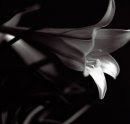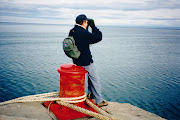300 tiles.
That was how many Bruce ordered for the guest bathroom. That was almost how many he used. There were a few left. I store them in the garage. They are bone-colored. Some are square. Some are elongated and bull-nosed. They sit in their open cardboard boxes like perfect teeth, like baby teeth, that smooth but sharp edge without a single bit of use.
Bruce died a few weeks after finishing the bathroom. When I look at the tile now, I see Bruce. I see him, and my husband, shoulder to shoulder, slapping on the gray mud, putting each tile in place according to the plan Bruce laid out. When Bruce showed me the design, sketched with precision on draftsman's paper, it looked like a river cutting through algebra. I'd asked him to use polished pebbles in the design, to soften all the hard-edged white. I don't want it to look like a hospital, I said. I want it to look like earth and cloud. The pebbles formed a wild, haphazard but contained band, weaving through the perfect order.
I never counted how many pebbles. There are hundreds.
Day after day Bruce and my husband worked to fit each tile and stone into its preordained palm of mud. They talked. They discovered they were the same age. Shared many of the same experiences, of the same places. Or they listened to the radio and slapped and stuck in silence. So many pebbles. It takes concentration as well as teamwork.
It took almost two weeks to finish the remodel.
When Bruce's wife told us Bruce had died, we refused. It wasn't possible. Bruce was too young. Only 63. We'd just gotten to know him. Bruce and my husband were fast becoming friends. They were going to play croquet. They even looked the same, the same gray, grizzled beard and wild hair, though Bruce was shorter and stockier, and more deliberate. He stared at problems until they were solved, moved slowly, made sure everything was right. Left to our own devices, we would simply have guessed how many tiles. We are haphazard, that way. Bruce aimed.
We cried, my husband especially. How can you be a man, a friend, cheeks flushed red in labor, at one moment, and then a cold ember fallen next to a pick-up truck, the next?
I went and stood in the bathroom. A kind of horror swept over me. A good man had spent some of the last weeks of his life in this small room, because I'd wanted my guests to have fresh grout. Given a choice, would anyone do this? If you could know these are my last weeks on earth? And how slow had I been to choose between three shades of white? Bone, white, cream? How many days had I wasted?
Bruce's wife invited us over to their house, three streets down from ours. A beautiful house, with snug rooms in colors of firefly matings. Bruce had started an addition, off the kitchen. He was doubling the size of the place. He had the foundation done, the walls, the roof supported by thick beams, the pounded earth floor. He had also just finished a deck for another neighbor, a tricky assignment: the Trex had had to be cut like a river to fit around trees, stones, in the undulating landscape.
He was very proud of the finished deck, she said. Bruce was a trusted problem-solver, and beloved for that. She knew something was wrong when he didn't come home from the deck-job. She found him beside the truck, eyes open and surprised. The days since then, she said, had been terrible and beautiful. On some days life was so exquisite you looked at the clouds and every pore of light registered.
She showed us pictures of Bruce going back to their college days, when they had met, in art school. He had always been a builder, a maker. He had always been prized for his work and the care with which he undertook and finished it. She showed us some of his paintings, still-lifes, beautiful. But he mostly chose houses and decks and tile and stone and pounded earth. What people live in, not with. She took us to his workshop, stuffed with tools and long, painted trim boards. Deep blue.
The other day, I carefully cleaned the tiles in the bathroom. The pebbles, in blues, grays and greens, are cut in half, so they lie flat and smooth, also easy to clean.
Can we put a niche in, I asked at the last minute, for the shampoo bottles? Framed in the bull-nose? With a pebble backing?
Bruce rubbed his beard, thought about it. I never saw him answer quickly.
Yes.
The niche for the shampoo bottles took an entire day to build and complete.
It is the most beautiful part of the bathroom, like something you would find built into an Etruscan wall, or the space left when a trout vanishes.
--M
Saturday, January 24, 2015
The Compiler
"I asked Marcy if there was a bird she’d always longed to see in the Matheson Wetlands Preserve but still hadn’t. She told me that every year she hoped for a pygmy owl. In this bad weather, she said, owls might be out—it was just dark enough, nearly crepuscular. (Google has a website, Ngram, that counts how many times a word has been used in print between the years 1800 and 2000. “Crepuscular” is on the decline.) No sooner had Marcy said this than I started imagining I was hearing hoots."
My thanks to Flyway: Journal of Writing and Environment, for publishing my story about bird-watching and bird-counting. You can read the full story here.
My thanks to Flyway: Journal of Writing and Environment, for publishing my story about bird-watching and bird-counting. You can read the full story here.
Live Toy, Dead Toy
"The desert is made for solitude. There is no exchange. No conciliating. No compromise. It doesn’t barter. If the desert shows you something beautiful—a slot canyon filled with light as the sun passes over—it isn’t because it cares what you will think of it. It doesn’t woo or spurn, it has no expectations, it shines without being a mirror, it goes deep without meaning anything profound. The blackbrush isn’t hellish, and the rabbitbrush, also known as chamisa, doesn’t care what you call it, and neither does the rabbit you almost never see next to it. The tumbleweed is stubborn but it isn’t going anywhere decided."
Read my story about the Utah canyonlands, married life, the intensity of dogs and the mad tug of the heart, published, with my thanks to all the good folks there, in the Kenyon Review.
Read my story about the Utah canyonlands, married life, the intensity of dogs and the mad tug of the heart, published, with my thanks to all the good folks there, in the Kenyon Review.
Subscribe to:
Posts (Atom)












